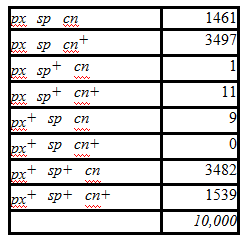High-intensity training in racehorses results in ____
a. the expression of genes involved in energy metabolism, insulin response, and muscle inflammation
b. the expression of genes involved in metabolism, oxidative phosphorylation, and muscle structure
c. no phenotypic or biochemical changes
d. no change in the expression of genes, but changes in phenotypes
e. changes in the expression of genes, but no changes in phenotypes
ANSWER: b
You might also like to view...
Which of the following linkage maps correctly shows the order and distance between the px, sp, and cn genes?
Females heterozygous for the recessive second chromosome mutations px, sp, and cn are mated to a male homozygous for all three mutations. The offspring are as follows:

A) sp——0.21 m.u.——px——30.01 m.u.——cn
B) sp——30.01 m.u.——px——0.21 m.u.——cn
C) sp——0.2 m.u.——px——30 m.u.——cn
D) px——0.2 m.u.——sp——30.2 m.u.——cn
E) px——30.2 m.u.——sp——0.2 m.u.——cn
The buffering capacity of hemoglobin is directly related to its ability to bind with
A) oxygen. B) carbon monoxide. C) carbon dioxide. D) hydrogen ions. E) nitrogen.
A genus is composed of a number of similar...
a) kingdoms b) orders c) phyla d) species
At the end of _____ and cytokinesis, haploid cells contain chromosomes that each consist of two sister chromatids.
A) metaphase II B) telophase I C) telophase D) telophase II E) interphase